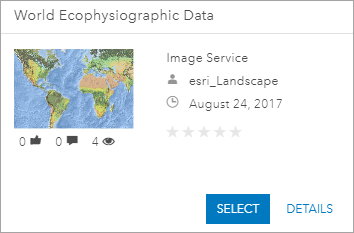Esri hosts and maintains weighted overlay services that represent physiographic and ecological data at a global scale. You can use these services in ArcGIS GeoPlanner to identify locations based on your criteria and answer geographic questions.

However, you may want to perform analysis using datasets that represent different criteria. Your organization can host its own data on ArcGIS Enterprise in a weighted overlay service. You can then consume that service in GeoPlanner for suitability modeling. This would allow you to share your data and analysis tools with specific groups, organizations, or the public.
This document introduces the concepts you'll need to understand to set up your own weighted overlay service.
Configuration overview
Hosted weighted overlay services are built from mosaic datasets that are shared as image services. This functionality uses various ArcGIS tools and components. You'll need the following components to set up your own weighted overlay service:
- ArcGIS Enterprise with ArcGIS Image Server 10.8.1 or later
- ArcGIS Pro
- Weighted Raster Overlay Service toolbox
- One or both of the following:
- ArcGIS Online organization, with a named user license for GeoPlanner
- ArcGIS Enterprise organization with a named user license for GeoPlanner
- One or both of the following:
- ArcGIS Web AppBuilder with the Suitability Modeler Widget
- GeoPlanner
There are three general workflows you'll need to follow to configure and share your own weighted overlay service. The Weighted Raster Overlay Service toolbox contains analysis tools that will help you prepare and configure your data for a weighted overlay service. Use of these tools is recommended as they will apply the proper fields, properties, and metadata to your rasters and mosaic datasets.
Prepare your data
The first step is to prepare your data for weighted overlay analysis. Because weighted overlay services are based on raster layers, you may have to convert existing vector data to raster data. You can use the Feature to Raster tool included with the Weighted Raster Overlay Service toolbox. This tool converts existing vector data to geoTIFF. You can also use other tools to convert or create raster datasets from vector datasets.
Learn more about preparing your data for weighted overlay analysisAdd data to a mosaic dataset
A mosaic dataset provides the layers that you will use in your weighted overlay service. Prior to creating and populating a mosaic dataset, you need to add some extra information to your raster datasets. This information includes the layer titles, input data ranges, range labels, and suitability scale mappings that will display in your weighted overlay service. You can use the Configure Raster Fields tool in the Weighted Raster Overlay Service toolbox to add this information.
Learn more about adding your data to a mosaic datasetPublish your data as a weighted overlay service
To make your mosaic dataset available as a weighted overlay service, you have to share it as an image service to an ArcGIS Image Server site. This step includes adding a tag, weightedOverlayService, when you share the item to your portal so that GeoPlanner can identify it as a weighted overlay service.
Learn more about publishing your data as a weighted overlay service